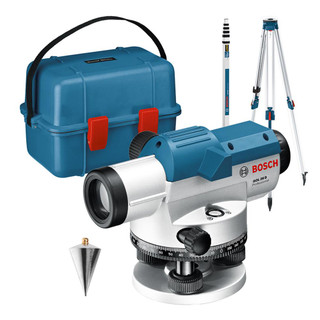
Bosch GOL 26 D Optical Level with BT160 Tripod, GR500 Measuring Rod & Case
(220595)£233.32EX VAT(£279.98 INC VAT)
Optical Levels
Optical levels are precision instruments designed for accurate levelling and angle measurements on site. Ideal for tasks like foundation setting, drainage work, and building alignment, these tools provide the reliability needed for surveying and construction tasks. With clear optics and robust build, they ensure precise readings, even in challenging site conditions.
What Are Optical Levels Used For?
- Foundation Setting Ensures that base levels are accurate before pouring concrete, crucial for structural integrity.
- Drainage Work Helps in planning and executing proper slope for efficient water runoff, preventing future issues.
- Building Alignment Maintains straight and level lines across long spans, aiding in wall erection and structural consistency.
- Landscaping Assists in creating level ground and features, ensuring aesthetic and functional landscaping results.
Who Uses Optical Levels?
- Surveyors and site engineers for precise measurements and layout planning.
- Groundworkers and landscapers needing accurate level data for effective land shaping.
- Builders and bricklayers ensuring structures are erected on a true level base.
- Drainage specialists for planning and verifying effective water flow paths.
Choosing the Right Optical Level
Select an optical level that matches your site needs for precision and ease of use:
1. Magnification Power
Higher magnification (like 32x) offers greater precision over long distances, ideal for larger sites and detailed surveys.
2. Build Quality
Choose robust, weather-resistant models for outdoor use. Look for features like dust and water resistance (IP54 or higher).
3. Tripod Compatibility
Ensure the level is compatible with standard tripods, providing stability and ease of use across various terrains.
Essential Accessories for Optical Levels
Boost your levelling accuracy and efficiency with these essential accessories:
1. Tripods
A sturdy tripod provides the necessary stability for accurate readings, particularly on uneven ground.
2. Levelling Staffs
Paired with your optical level, these allow for precise measurement of elevation differences on site.
Optical Level FAQs
How do I calibrate an optical level?
Calibration is typically done using the two-peg test, where you take readings at two points and adjust the level until they match.
Can optical levels be used in low light conditions?
Yes, many optical levels are equipped with high-quality optics that allow for clear visibility even in low-light environments.
What maintenance is required for an optical level?
Regular cleaning of the lens and ensuring the device is kept dry and dust-free will prolong its accuracy and lifespan.




